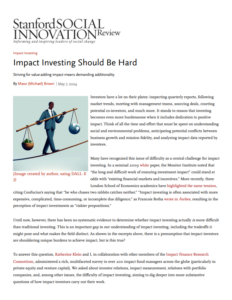The Perceived Difficulty of Impact Investing
At the Georgia Social Impact Collaborative, we champion the idea that impact investing is about more than balancing financial return and mission. It’s about leaning into the complexity required to drive real change. A recent article in Stanford Social Innovation Review underscores this point, challenging the field to resist the temptation of oversimplification and to embrace the difficult—but necessary—work of delivering additionality.
Here in Georgia, our work at GSIC revolves around fostering connections and elevating investments that not only perform but transform. This article reaffirms a belief many in our network hold: the most meaningful impact often comes with discomfort, complexity, and tension. And that’s okay. We invite our partners—foundations, banks, mission-driven capital holders—to reflect on the question: Are we chasing convenience or change?
Key Insights from the Article
Impact investing is often perceived as more burdensome than traditional investing due to the added complexity of addressing social and environmental issues alongside financial returns. This perception is supported by a 2009 Monitor Institute white paper and recent observations by London School of Economics academics, who highlight the challenges and perceived risks associated with impact investing.
A recent article in Stanford Social Innovation Review challenges the impact investing field to resist the temptation of oversimplification and to embrace the difficult—but necessary—work of delivering additionality. The SSIR article leverages data from a survey conducted by Katherine Klein and the Impact Finance Research Consortium, involving over 200 impact fund managers. Contrary to some common beliefs in the field, this survey and the SSIR article reveals that market-rate-seeking impact investors generally do not find their work more difficult than traditional investing, contrary to those targeting below-market returns who report higher levels of difficulty. We jotted down the following notes while reading:
The survey’s counterintuitive results suggest that market-rate-seeking impact investors might simplify their work by integrating impact with financial performance, viewing them as intertwined. This belief allows them to gauge impact through financial metrics, reducing the perceived difficulty. In contrast, below-market-rate impact investors often emphasize rigorous impact assessment due to their mission-driven focus. The findings raise questions about whether impact investing is living up to its promise of additionality and distinctiveness compared to traditional investing, especially in addressing neglected social and environmental challenges.
Share Your Reactions With Us
We hope you’ll take time in the coming weeks to read the full article here: Impact Investing Should Be Hard – SSIR, and we invite you to let us know what you think! Do you agree with these conclusions? Were there elements that challenged you? How you’re navigating these tensions in your own investing strategies?


